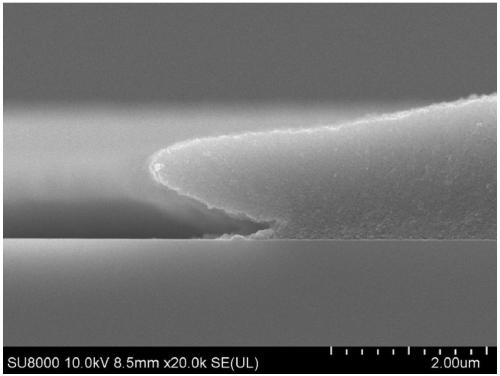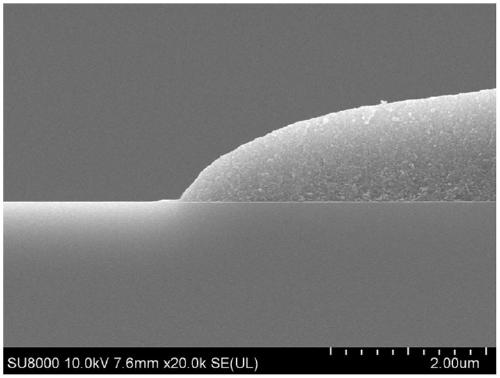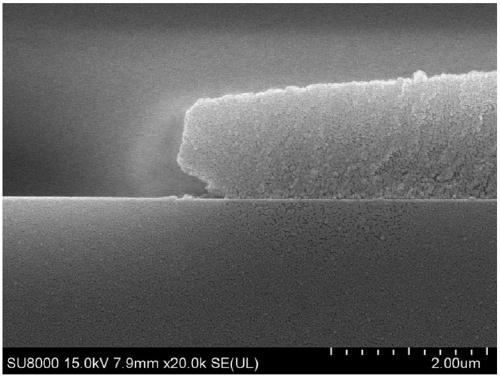Photosensitive resin composition, application thereof and color filter
A color filter, photosensitive resin technology, applied in the field of photoresist, can solve the problems of incomplete inverted trapezoidal structure, low curing degree, insufficient polymerization degree, etc., to improve the surface concentration, optimize the surface flatness, The effect of increasing the degree of response
- Summary
- Abstract
- Description
- Claims
- Application Information
AI Technical Summary
Problems solved by technology
Method used
Image
Examples
preparation example 1
[0063] The preparation method of modified photoinitiator 1 is as follows:
[0064] (1) In a four-necked bottle equipped with a stirrer, a thermometer, a chlorine protection device and a dropping funnel, under a chlorine atmosphere, add hydrogen-containing silicone oil 1 (n≤20) 100 parts by weight, and 800 parts by weight of organic solvent acrylate, heated to 116° C., added 30 parts by weight of chloroplatinic acid through a dropping funnel, and reacted for 3 hours. After the reaction is complete, gradually lower the temperature to room temperature under stirring, extract with toluene, and remove the toluene by distillation to obtain an intermediate product.
[0065] (2) In the there-necked flask equipped with agitator, thermometer and dropping funnel, add photoinitiator 4,4-bis(diethylamino)benzophenone 100 parts by weight and 1000 parts by weight of toluene, heated to dissolve the photoinitiator, heated to 85°C, added 50 parts by weight of the intermediate product, and pl...
preparation example 2
[0070] The difference from Preparation Example 1 is that hydrogen-containing silicone oil 1 is replaced by hydrogen-containing silicone oil 2 (n 1 +n 2 ≤20), obtaining the modified photoinitiator 2 with a yield of 89.2%
[0071] Structure Characterization:
[0072] (1) Dissolve modified photoinitiator 2 in tetrahydrofuran, use Waters-Breeze GPC gel permeation chromatography to characterize, record M w = 2890, PDI = 1.026.
[0073] (2) Use nuclear magnetic resonance spectrometer equipment to characterize, under 400MHz with CDCl 3 into the solvent 1 H NMR test, the results are as follows: δ=0.15ppm (12H, s), 0.62ppm (6H, s), 1.18ppm (12H, t), 2.85ppm (2H, t), 7.36~7.72ppm (7H, t) .
preparation example 3
[0075] The difference from Preparation Example 1 is that hydrogen-containing silicone oil 1 is replaced by hydrogen-containing silicone oil 3 (n 1 +n 2 ≤20), obtaining yield is 89.5% modified photoinitiator 3: mixture.
[0076] Structure Characterization:
[0077] (1) Dissolve modified photoinitiator 3 in tetrahydrofuran, use Waters-Breeze GPC gel permeation chromatography to characterize, record M w = 3050, PDI = 1.158.
[0078] (2) Use nuclear magnetic resonance spectrometer equipment to characterize, under 400MHz with CDCl 3 into the solvent 1 H NMR test, the results are as follows: δ=0.14ppm (12H, s), 0.61ppm (6H, s), 1.17ppm (12H, t), 2.80ppm (2H, t), 7.35~7.71ppm (7H, t) .
PUM
 Login to View More
Login to View More Abstract
Description
Claims
Application Information
 Login to View More
Login to View More - R&D
- Intellectual Property
- Life Sciences
- Materials
- Tech Scout
- Unparalleled Data Quality
- Higher Quality Content
- 60% Fewer Hallucinations
Browse by: Latest US Patents, China's latest patents, Technical Efficacy Thesaurus, Application Domain, Technology Topic, Popular Technical Reports.
© 2025 PatSnap. All rights reserved.Legal|Privacy policy|Modern Slavery Act Transparency Statement|Sitemap|About US| Contact US: help@patsnap.com



